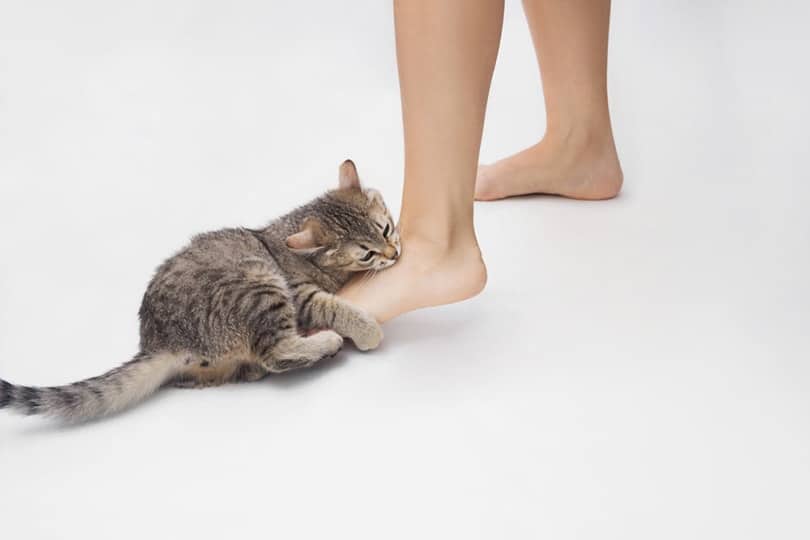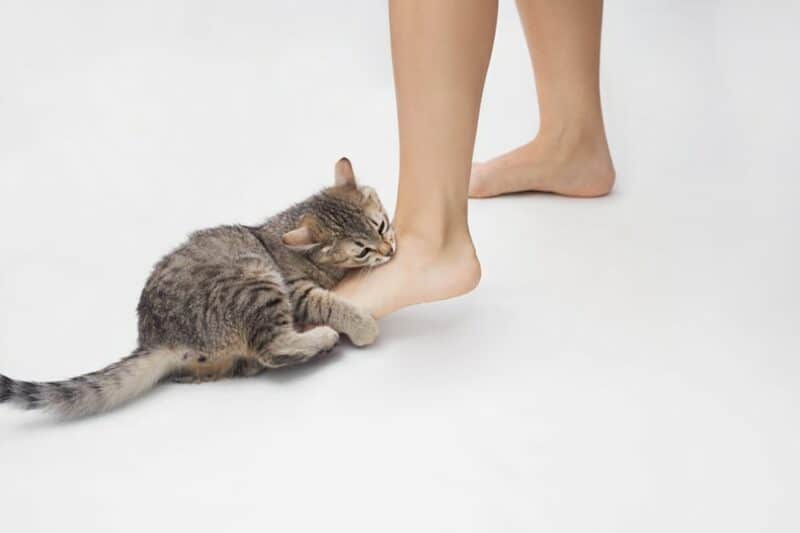Is your cat constantly biting you? You are not alone. The behavior is typical for kittens and adult cats, but they do it for different reasons. Adult cat bites are painful and potentially dangerous, but bites from kittens shouldn’t be tolerated either. However, it’s possible to train your cat not to bite, regardless of age.
Here, we offer seven tips and tricks on how to do that. But first, let’s look at some of the most common reasons cats bite.
Possible Reasons Why Your Cat Bites You
Cats bite for different reasons. Understanding the motivation behind the bites is the first step in learning how to stop the behavior.
1. Play Aggression
Kittens learn vital communication and hunting skills through play. Due to their predatory instincts, they usually engage their siblings in rough play, which often involves claws and teeth.
The mock-fighting is an opportunity to test personal limits, and it helps the kittens learn valuable social skills. For instance, a kitten can only know that bites hurt because of the reaction they get from their sibling playmates.
2. Seeking Attention
A cat can do several things to get your attention when hungry, bored, or craving affection. They can meow, rub against you, stare at you. But they can also bite you.

3. Asserting Dominance
Some cats want to assert their dominance through physically aggressive acts, such as biting, scratching, and swatting. They usually do it with other cats in the home but can also do it with you. Cats usually assert dominance when they feel threatened, and sometimes, they accompany the biting with a hiss or growl.
Biting could also be a form of expressing agitation when a cat wants you to stop doing something. Perhaps they have had enough of the petting and grooming. After giving off several warnings, they can make good the threat by biting you.
4. Stress or Pain
A cat biting you could also be a reaction to stress or pain. They could be a way of expressing discomfort when other visual and verbal forms of communication fail. A cat can also bite you if biting has helped ease their discomfort before.
A cat will also bite you if biting has helped them ease other forms of discomfort before. For instance, biting you might have saved them from an unpleasant trip to the vet, nail clipping, or bath time. So, they might try their luck the next time they feel uncomfortable.
The 7 Tips How to Train a Cat Not to Bite You
Training a cat to stop a behavior requires patience, especially when dealing with an adult feline. But it is possible if you do it with care and persistence.
Here are seven tips and tricks you can try.
1. Don’t Jerk Your Hand Away
When a cat bites you, the instinctive reaction is to jerk your hand away. But that is a bad idea. A cat will instinctively bite harder if you do that, the same way that they would if a prey under their grasp tried to escape.
Instead of pulling away, try pushing the hand farther into the cat’s mouth. That may seem counterintuitive, but it could mean the difference between getting free and excruciating pain. The move will catch the cat by surprise, prompting them to let go.
2. Don’t Punish Right Away
You might be tempted to discipline the cat by shoving or yelling at them after a bite, but that will only fuel the fire. Your cat might interpret it as rough play and keep returning. Moreover, you might overdo it and end up scaring the cat.
That could trigger stress-related behavior such as aggression, withdrawal, or urinating outside the litter box. The best reaction in this situation is to leave the scene for several minutes. If you do that enough times, the cat will learn that biting interrupts playtime and stops any form of attention.
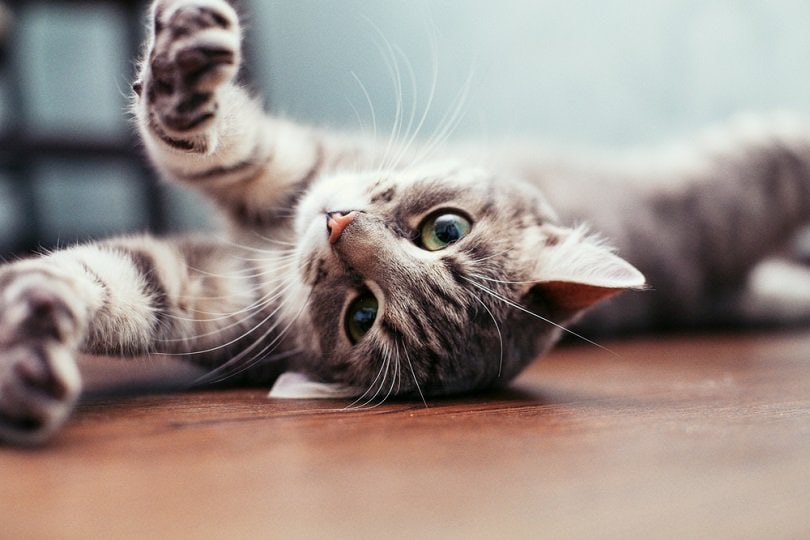
3. Redirect Them With a Toy
Never use your hands or toes when playing with the cat. Moving them around for the kitty to chase will only reinforce the behavior. Next time, they might pounce on and bite them when you are not even looking.
Physical play and mental stimulation are essential, and if the cat is using your hand for play, consider buying toys. Ensure you get several interactive ones (at least four) so your cat doesn’t get bored. You can use them to redirect the feline’s attention before they go for your hand.
4. Reward Good Behavior
One of the most effective ways to change or influence a cat’s behavior is through positive reinforcement, where you encourage good behavior by offering rewards and treats. You can utilize this technique when training your furry friend to stop biting.
You can utilize this technique when training your furry friend to stop biting. For instance, whenever the cat goes for the toy instead of your hand, you can encourage the behavior by cuddling them, speaking softly, or offering them a treat.
You can also offer treats and praise when your cat uses their soft paw or a gentle rub to get your attention instead of biting.
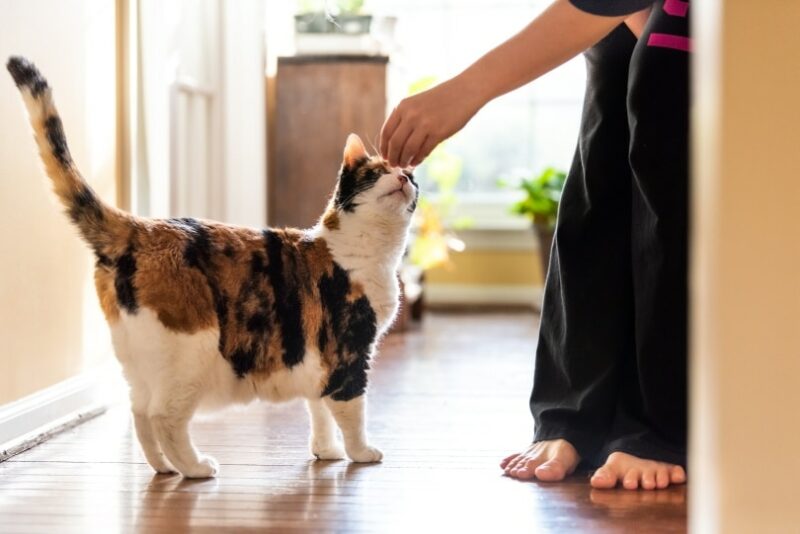
5. Keep Your Cat Calm and Relaxed
One of the reasons why cats get stressed or frustrated is change. Kitties love the familiar and act out (sometimes through biting) when there are changes in their routine or environment.
You can remedy the situation by keeping things consistent, including the time for meals, napping, and playing. Only make changes if necessary. Otherwise, keep the schedule predictable to ensure your cat remains calm and confident.
A cat can feel stressed without adequate food, play, or sleep. So, feed them a healthy and balanced diet, and set away time during the day for mentally stimulating play. Also, ensure that their nap schedule is not interrupted.
6. Be Consistent
All these tips and tricks will not work unless you’re consistent. If you plan to leave the scene when your cat goes for your hand, you should do that every time.
Other household members also need to be onboard since the training won’t work if you are not all doing the same thing.
If someone reacts differently, your cat could get confused. Visitors can complicate matters, and it’s better to let them know as well.
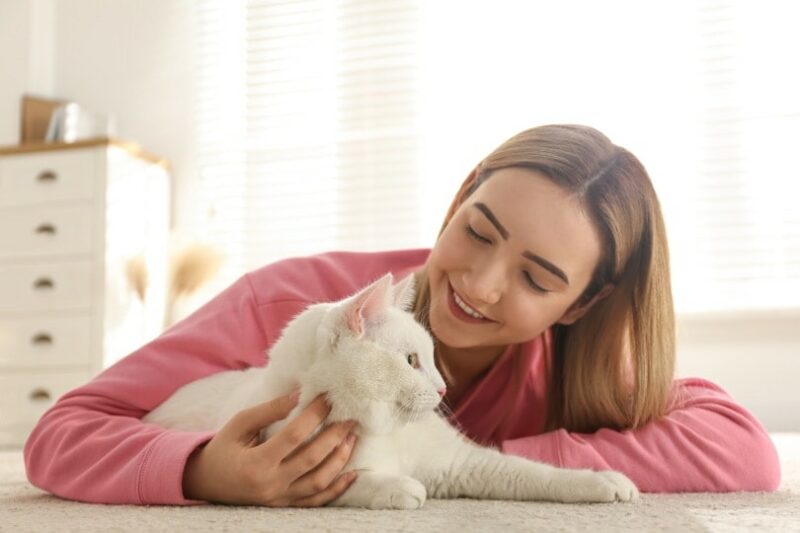
7. Visit a Vet
Your cat can quickly lose their temper if they’re sick or injured. Pain may provoke them to act aggressively by scratching, growling, or biting.
Consult a veterinarian if you suspect your cat’s sudden change in behavior is due to an underlying medical condition. The aggression could be pain related, and it’s difficult to tell since cats are good at hiding pain.
If your cat is stressed, the vet could also recommend wellness tools and supplements to help the kitty remain calm and relaxed.

How to Treat a Cat Bite
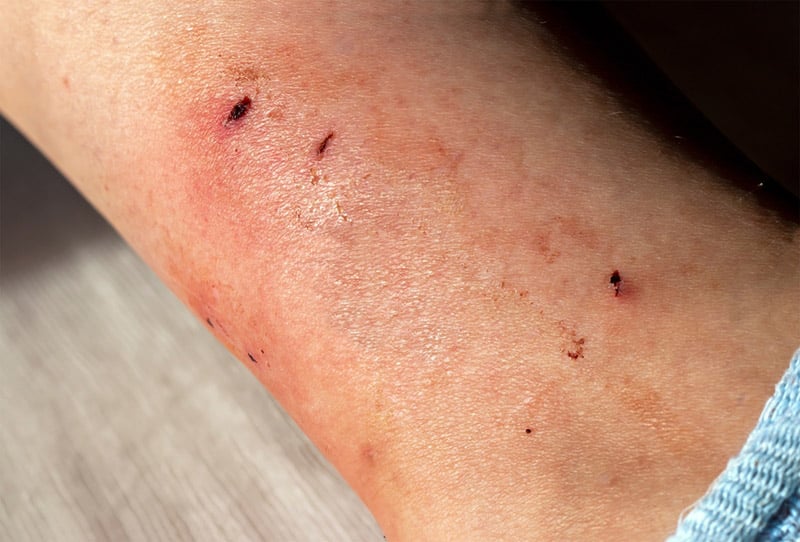
Cat bites are dangerous to humans and other pets. Since the punctures are small, they usually seal up quickly, trapping the bacteria inside. One of the most common bacteria is Pastuerella multocida, which is present in 70% to 90% of cats1.
If your cat bites you, you need to act fast by doing the following:
- Press on the wound to flush out the bacteria.
- Wash the wound with soap and water.
- Dry and dress the wound.
- Visit a doctor.
- Monitor the wound for infection.
The doctor will examine you to determine whether you need additional treatment. They might rewash the wound, stitch it up, and prescribe antibiotics. If you suspect an infection is spreading, visit the doctor immediately for treatment. Signs of infection include:
- Swelling
- Pain
- Redness
- Oozing
- Fever
Conclusion
Cat bites can be painful and dangerous. Luckily, it is possible to train your cat to stop the behavior. It’s not a walk in the park and requires a lot of time and patience. Moreover, it won’t work unless you do it consistently.
Everyone in your home, including visitors, should follow the plan. Remember, rewards work better than punishment. So, you’ll have a better chance of succeeding if you employ positive reinforcement techniques.
Featured Image Credit: Marina-Demeshko, Shutterstock

